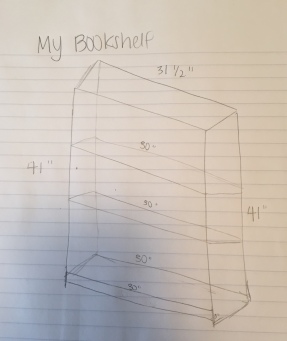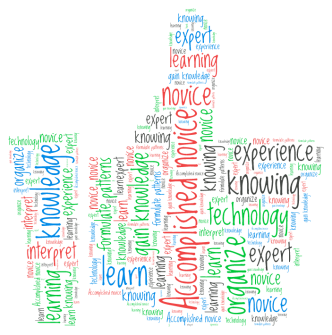I usually love department stores. The kind with clothes, shoes and accessories everywhere I turn. But take me out of that kind of department store and put me in the kind with doors, spray paint, nails, drywall and toilets; I’m lost.

I hope the STOP sign wasn’t trying to tell me something…
That’s how I felt today when I went to Home Depot to get supplies to build my bookshelf.
I had a list of what I needed and the dimensions of the wood I would need to buy from one of my resources, Ana White’s blog. This blog really helped me because it gave me a picture of what I was building and the dimensions in basic terms. She also listed other supplies I would need, so I knew what else I had to purchase if I didn’t already own it like wood glue, sandpaper and 2” screws.
From there, I could draw a sketch of my bookshelf.

I walked to the ‘lumber’ aisle and was overwhelmed with the different types of wood there were. Thick, thin, dark, light; I really could go on. My biggest challenge was initially figuring out what type of wood I wanted. The website said one thing and I thought something else. I asked a Home Depot employee for help and asked him many questions about each type of wood.
Without Khalid’s help, I truly would not have known what to do. I explained to him what I was building and what I needed. He showed me a few types of wood and I decided to get a ¾” thick plywood that seemed perfect to build a bookshelf. He took the 4 ft by 8 ft piece off the stack and I gave him the dimensions of the pieces of wood I needed. He took the wood back to the vertical saw at the store and started cutting the wood for me. Honestly, there was no way I’d be able to fit that in my car!
I really wanted to learn how to use a table saw, but because I don’t have those resources available to me (or the $$), I used the resource at Home Depot to help me get closer to building my bookshelf.
Another challenge I faced was the plywood for the back of the bookshelf. The online blog I had been using said I should get plywood for the back of the bookshelf. Khalid explained to me the only piece he had was 4ft by 8ft which is way bigger than what I needed. Being a teacher on a budget, I also couldn’t afford to buy a huge piece of wood I would only use a quarter of. My solution on the spot was to just nix the back of the bookshelf. I figure I could make a bookshelf you can access from both sides instead of just one. I might change my mind later, but I can always go back and get the plywood I need.

Who knew there were so many different types of screws?!
Before I get to the real building, I wanted to practice my gluing and sanding skills. I show these two new skills in the video below.
I wanted to wait until my official building day to learn how to use a drill and hammer properly. I’ll be building the bookshelf at my dad’s store, Exercise Warehouse. He has a warehouse in the back with proper tools and a power drill. I’ve been researching how to use a power drill so I am familiar and comfortable enough with it before my dad shows me the real thing.
I’m excited to start building. It’s hard to visualize all of these planks of wood will be built into something substantial I can use in my house or in my classroom.
Maybe this will be my new Nordstrom? Maybe not… let’s see how it goes!







